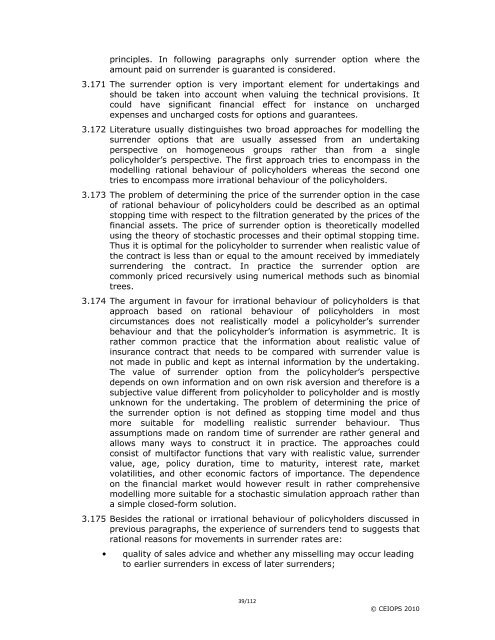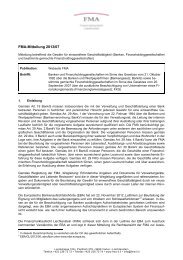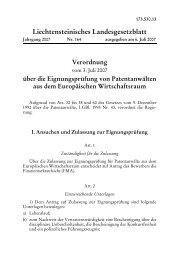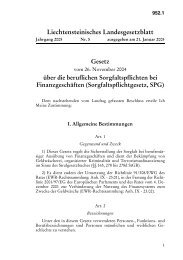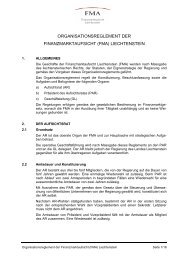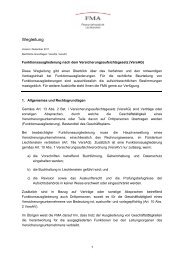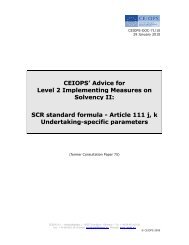CEIOPS' Advice for Level 2 Implementing ... - EIOPA - Europa
CEIOPS' Advice for Level 2 Implementing ... - EIOPA - Europa
CEIOPS' Advice for Level 2 Implementing ... - EIOPA - Europa
You also want an ePaper? Increase the reach of your titles
YUMPU automatically turns print PDFs into web optimized ePapers that Google loves.
principles. In following paragraphs only surrender option where the<br />
amount paid on surrender is guaranted is considered.<br />
3.171 The surrender option is very important element <strong>for</strong> undertakings and<br />
should be taken into account when valuing the technical provisions. It<br />
could have significant financial effect <strong>for</strong> instance on uncharged<br />
expenses and uncharged costs <strong>for</strong> options and guarantees.<br />
3.172 Literature usually distinguishes two broad approaches <strong>for</strong> modelling the<br />
surrender options that are usually assessed from an undertaking<br />
perspective on homogeneous groups rather than from a single<br />
policyholder’s perspective. The first approach tries to encompass in the<br />
modelling rational behaviour of policyholders whereas the second one<br />
tries to encompass more irrational behaviour of the policyholders.<br />
3.173 The problem of determining the price of the surrender option in the case<br />
of rational behaviour of policyholders could be described as an optimal<br />
stopping time with respect to the filtration generated by the prices of the<br />
financial assets. The price of surrender option is theoretically modelled<br />
using the theory of stochastic processes and their optimal stopping time.<br />
Thus it is optimal <strong>for</strong> the policyholder to surrender when realistic value of<br />
the contract is less than or equal to the amount received by immediately<br />
surrendering the contract. In practice the surrender option are<br />
commonly priced recursively using numerical methods such as binomial<br />
trees.<br />
3.174 The argument in favour <strong>for</strong> irrational behaviour of policyholders is that<br />
approach based on rational behaviour of policyholders in most<br />
circumstances does not realistically model a policyholder’s surrender<br />
behaviour and that the policyholder’s in<strong>for</strong>mation is asymmetric. It is<br />
rather common practice that the in<strong>for</strong>mation about realistic value of<br />
insurance contract that needs to be compared with surrender value is<br />
not made in public and kept as internal in<strong>for</strong>mation by the undertaking.<br />
The value of surrender option from the policyholder’s perspective<br />
depends on own in<strong>for</strong>mation and on own risk aversion and there<strong>for</strong>e is a<br />
subjective value different from policyholder to policyholder and is mostly<br />
unknown <strong>for</strong> the undertaking. The problem of determining the price of<br />
the surrender option is not defined as stopping time model and thus<br />
more suitable <strong>for</strong> modelling realistic surrender behaviour. Thus<br />
assumptions made on random time of surrender are rather general and<br />
allows many ways to construct it in practice. The approaches could<br />
consist of multifactor functions that vary with realistic value, surrender<br />
value, age, policy duration, time to maturity, interest rate, market<br />
volatilities, and other economic factors of importance. The dependence<br />
on the financial market would however result in rather comprehensive<br />
modelling more suitable <strong>for</strong> a stochastic simulation approach rather than<br />
a simple closed-<strong>for</strong>m solution.<br />
3.175 Besides the rational or irrational behaviour of policyholders discussed in<br />
previous paragraphs, the experience of surrenders tend to suggests that<br />
rational reasons <strong>for</strong> movements in surrender rates are:<br />
• quality of sales advice and whether any misselling may occur leading<br />
to earlier surrenders in excess of later surrenders;<br />
39/112<br />
© CEIOPS 2010


